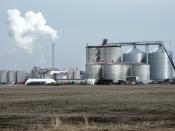In the 1860's, wood was the number one fuel for heating and cooking in homes and businesses, and was used for steam in industries, trains, and boats. By the 1900's, Ethanol was competing with gasoline to be the fuel for cars. By the 1970's, Some Americans used more wood for heating because of higher energy costs. Some industries switched from coal to waste wood. The paper and pulp industry also began to install wood and black liquor boilers for steam and power displacing fuel oil and coal. In 1985, The biomass power industry in California began to grow, eventually adding 850 megawatts of power due to fuel cost escalation clauses in the Standard Offer contracts (based on predicted oil costs of $100 a barrel-these 10-year contracts guaranteed power purchase rates). By 1990, Electricity generating capacity from biomass (not including municipal solid waste) reached 6 gigawatts. Of 190 biomass-fired electricity generating facilities, 184 were nonutility generators, mostly wood and paper.
**Biomass is organic material which has stored sunlight in the form of chemical energy. It is usually thought of as garbage. Biomass can be dead trees, tree branches, yard clippings, left-over crops, wood chips, bark and sawdust, even old tires and livestock manure.
After biomass is collected, it is then burned. When garbage decomposes, it gives off methane gas (Methane is in natural gas also.). Thus, landfills are full of methane gas from the decomposing garbage. Pipelines are put in the landfills to capture the methane gas, which can later be used in power plants to make electricity.
An example of biomass making energy is when farmers burn manure from animals, which also contains methane gas, to power their farm.
A gas-like fuel is methane. It can be collected at landfills, as stated above. This gas can be used in a...


